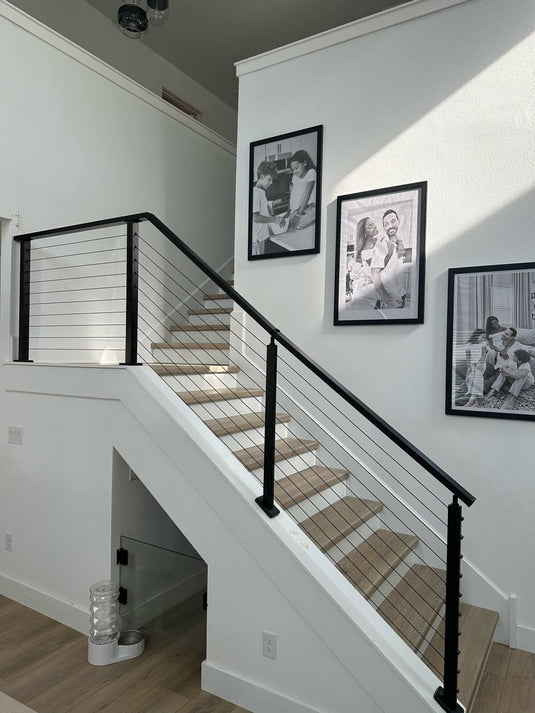TABLE OF CONTENTS
Choosing the Perfect Wood Stair Railing for Your Home
Picture this: You've just moved into your dream home, but every time you walk up the stairs, that outdated railing catches your eye—and not in a good way. It feels cold, impersonal, and completely out of sync with the warm, inviting vibe you've envisioned. Sound familiar? You're not alone. For many homeowners, the staircase with wooden railing isn't just a safety feature—it's the soul of the home, a chance to weave personality into every step.

--Photo Credit: Muzata Customer
Let's face it: Your wood stair railing does more than keep you from tripping. It's a design anchor, a conversation starter, and a reflection of your taste. But how do you choose the perfect one?
💡Whether you're renovating a cozy Craftsman or crafting a minimalist oasis, this guide will help you navigate the world of wooden stair railings with confidence—and maybe even a little flair.
Why Choose Wood Stair Railings?
Wood has long been a favorite material for indoor railings in American homes, and for good reason. Its timeless elegance brings warmth and character to any interior stair railing, making it a versatile choice for various design styles. From the rustic charm of a farmhouse to the clean lines of a contemporary loft, a wooden stair railing adapts effortlessly.

--Photo Credit: Muzata Customer
Beyond aesthetics, wood offers exceptional durability. A well-crafted wood stair railing provides the strength needed to ensure safety, especially in busy households with children or pets. Plus, with proper maintenance, a staircase with wooden railing can last for decades, adding long-term value to your home.
Key Factors to Consider When Choosing Wood Stair Railings
Selecting the right wood stair railing involves balancing style, practicality, and budget. Here are the key factors to keep in mind:
1.Wood Type
The type of wood you choose for your wooden stair railing will significantly impact both its appearance and cost. Here are some popular options in the U.S.:
Oak: Known for its strength and prominent grain, oak is a budget-friendly choice for indoor railings. Red oak is warmer, while white oak has a more neutral tone.
Maple: With a smooth, subtle grain, maple is ideal for modern interior stair railings. It's durable and takes stains well.
Cherry: This luxurious wood darkens with age, offering a rich, elegant look for upscale staircases with wooden railings.
Walnut: Prized for its deep, chocolatey hues, walnut is perfect for high-end, contemporary wood stair railings.
Each wood type has its own charm, so consider your home's color palette and design vibe when deciding.

--Photo Credit: Muzata Customer
2. Design and Style
The design of your wood stair railing should complement your home's architecture. Traditional homes, like Colonials or Victorians, often feature turned balusters and ornate details, creating a classic staircase with wooden railing.

In contrast, modern homes lean toward sleek, minimalist indoor railings with straight lines and simple profiles. For a unique touch, consider mixing wood with other materials, such as metal balusters or glass panels, to create a hybrid interior stair railing that feels fresh and stylish.

--Photo Credit: Muzata Customer
3. Safety and Building Codes
Safety is paramount when designing a staircase with wooden railing. In the U.S., residential building codes dictate specific requirements for interior stair railings, including:
Height: Railings must typically be 34–38 inches high (IBC Code). While the International Building Code sets baseline standards, local jurisdictions often modify requirements based on regional risks. Always verify with local building departments—what's compliant in one state could fail inspection in another.
Baluster Spacing: Gaps between balusters should not allow a 4-inch sphere to pass through, ensuring child safety.
Load Capacity: Railings must withstand a certain amount of force to prevent accidents.

--Photo Credit: Manuel Maldonado / Muzata Customer
Always work with a professional to ensure your wood stair railing complies with local codes, providing peace of mind for your household.
4. Budget Considerations
The cost of a wooden stair railing varies based on wood type, design complexity, and whether you choose custom or pre-made options. For example, oak indoor railings are generally more affordable than walnut or custom-crafted interior stair railings. On average, homeowners can expect to spend $7500–$12,000 for a standard staircase, with high-end designs costing more.
To stay within budget, prioritize quality over extravagance. A well-made wood stair railing is an investment that enhances both your home's safety and resale value.
Popular Wood Stair Railing Trends in the U.S.
American homeowners and designers are embracing innovative trends for staircases with wooden railings. Here are some styles gaining traction:
Minimalist Designs: Clean, unadorned wood stair railings with slim profiles are perfect for modern homes, emphasizing simplicity and open space.

--Photo Credit: Manuel Maldonado / Muzata Customer
Mixed Materials: Pairing wood with metal cables or glass panels creates a striking interior stair railing that blends warmth with industrial flair.

--Photo Credit: Erik Patterson / Muzata Customer
Eco-Friendly Options: Sustainable woods like reclaimed oak or bamboo, paired with non-toxic finishes, appeal to environmentally conscious homeowners.
These trends offer endless inspiration for creating a staircase with wooden railing that reflects your personal style.
Maintenance Tips for Wood Stair Railings
To keep your wooden stair railing looking pristine, regular maintenance is essential. Here's how to care for your indoor railings:
Cleaning: Dust your wood stair railing weekly with a soft cloth to prevent buildup. For deeper cleaning, use a damp cloth with clean water or mild soap, followed by a dry cloth to avoid moisture damage.
Refinishing: Every 5–10 years, consider refinishing your staircase with wooden railing to restore its shine. Sand lightly, apply a fresh stain or sealant, and buff for a like-new look.
With proper care, your wood stair railing will remain a stunning focal point for years to come.

--Photo Credit: Robert Boltz / Muzata Customer
Conclusion
A wood stair railing is a powerful way to enhance your home's beauty, safety, and value. By carefully selecting the wood type, design, and finish, you can create a staircase with wooden railing that perfectly suits your style and needs.

--Photo Credit: Amber / Muzata Customer
📌Ready to transform your staircase? Start exploring wood options and designs today to find the perfect wooden stair railing for your home. For personalized advice, consult with muzata designer who can bring your vision to life.




